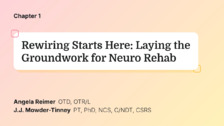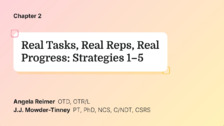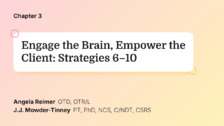Building Better Brains: Everyday Strategies to Spark
Neuroplasticity (Recorded Webinar)
Presented by J.J. Mowder-Tinney and Angela Reimer

12-Month Subscription
Unlimited access to:
- Thousands of CE Courses
- Patient Education
- Home Exercise Program
- And more
This course is a recording of a previously hosted live webinar event. Polling and question submission features are not available for this recording. Format and structure may differ from those of standard Medbridge courses.
Therapists often hear about neuroplasticity, but translating theory into effective, functional treatment can be overwhelming—especially in busy clinical environments. This webinar breaks down 10 core neuroplasticity principles and pairs each one with a creative, low-barrier intervention example and matching documentation verbiage.
The goal? To make implementation easy, immediate, and impactful across care settings. Whether you’re in acute care, IRF/SNF, home health, or outpatient, you’ll walk away with adaptable strategies that support better outcomes and patient engagement. This is neuro rehab that’s practical, research-backed, and just the right amount of fun.
Walk away with tools you can use tomorrow—and the documentation to prove it.
Learning Objectives
- Examine 10 core neuroplasticity strategies that support functional recovery and improve therapeutic outcomes
- Apply neuroplasticity principles to guide clinical decision-making during functional task training
- Construct documentation statements that reflect neuroplasticity principles to support skilled service justification
- Select external cues and practice types to promote motor learning and functional recovery
- Integrate salience, repetition, and error-based learning strategies to maximize therapeutic engagement and occupational participation
- Prepare strategies for facilitating client autonomy, aerobic capacity and metacognitive strategies for sustained performance improvements
Meet your instructors

J.J. Mowder-Tinney
Dr. J.J. Mowder-Tinney holds a bachelor of science degree in psychology from the University of Colorado Boulder, a master of science in physical therapy from the University of Miami, and a doctorate in physical therapy from Nova Southeastern University. With nearly three decades of diverse clinical experience, her expertise…

Angela Reimer
Dr. Reimer received both her bachelor of science degree in health sciences and master’s degree in occupational therapy from the University of Findlay and her doctorate in occupational therapy from Indiana University. She boasts more than 20 years of clinical experience with geriatric and neurologically impaired populations,…
Chapters & learning objectives

1. Rewiring Starts Here: Laying the Groundwork for Neurological Rehab
This chapter lays the groundwork by introducing the foundational concepts of neuroplasticity and why they matter across the continuum of care. We’ll explore the 10 core strategies that drive change in the nervous system and review real-world clinical constraints, including variations across settings and equipment availability. Participants will also learn key documentation tips to justify skilled interventions and reinforce decision-making rooted in neuroplasticity.

2. Real Tasks, Real Reps, Real Progress: Strategies 1–5
This chapter brings the first five strategies to life through creative, functional examples. For each strategy, participants will explore a specific intervention idea, supporting documentation language, and how to adapt the activity to different patients and environments. Special focus will be placed on salience, meaningful repetition, and purposeful challenge to increase engagement and participation.

3. Engage the Brain, Empower the Client: Strategies 6–10
In this final chapter, we’ll dig into the last five neuroplasticity strategies with more practical intervention ideas and language you can use immediately. We’ll highlight the power of external cues, explore different types of practice, and discuss how to foster autonomy and problem-solving in therapy. We’ll also emphasize the role of aerobic intensity—how to layer challenge into your sessions to promote change and accelerate outcomes. Building patient confidence and long-term carryover through metacognitive strategies and client-led progression will round out this action-packed finish.

4. Question and Answer Session
This chapter is a viewer-submitted question and answer session facilitated by J.J. Mowder-Tinney and Angela Reimer.